#daniel o'mahony
Explore tagged Tumblr posts
Text
The Killer Cats of Gin-Seng
In Survival, the last regular serial of Classic Doctor Who, the Doctor and Ace visit a planet of humanoid cats called “Cheetah People”. The Cheetah People are highly telepathic: they can mentally control and inhabit their pet cats, and they can even teleport between planets. Most notably, one of them is played by Lisa Barrowman, better known as Bernice Summerfield.
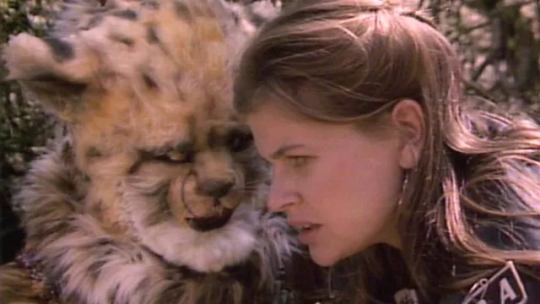
But this wasn’t actually the first time that humanoid cats had been set to appear in Doctor Who. In 1977, script editor Anthony Read commissioned his former collaborator David Weir to write the Season 15 finale, a four-part serial set on Gallifrey. The request was to explore society outside the Capitol with an emphasis on morality, a theme which Weir had written well in the past. So he pitched a story about Gallifreyan civilization of humanoid cats.
The Gallifreyan cat-people would have mirrored real-world cats’ dual penchant for both sophistication and savagery: they would appear advanced and civilized until the Doctor wound up in one of their elaborate gladiatorial displays! Weir delivered his scripts on time, and production proceeded to the point that Dee Robson designed costumes for the cat actors.

Ultimately the story was cancelled: Weir, by all accounts an excellent screenwriter, dramatically overestimated the show’s VFX capabilities and budget. But executive producer Graham Williams later mentioned the idea at a fan convention, so it became well-known in fandom (albeit under the false name The Killer Cats of Geng Singh). As a result, when Survival finally brought cat people to screens, fans naturally canonwelded the two.
One of these fans was Adrian Middleton, editor of the Apocrypha fanzine. Here’s how Apocrypha issue 1 covered the cats:
Apocrypha on the Killer Cats
THE GIANT CATS -16,000,000
The first intelligent mammalians on Gallifrey evolved from its version of the sabre-toothed Tiger. These giant cats developed a rudimentary form of empathic communication, which allowed them to influence the actions of their prey.
Over an extended period of time, the cats developed a finer telepathic ability, allowing them to actually control other species. This became a necessity as feline culture grew, as their physiological form prevented the use of tools to build or write with. Thus, in spite of their intelligence, the cats could not establish a true civilisation without anthropoid assistance.
FELINOID CIVILISATION -14,000,000
Early Gallifreyan hominids soon became the tools of feline culture. The first buildings on the planet were built by hominids but designed by cats, taking the form of vast stone arenas, in which the cats would use lesser species for sport - hunting and killing for pleasure rather than survival.
HOMINIDS -14,000,000/-13,980,000
Forced to live alongside saurian and feline predators, Gallifrey's first hominid tribes evolved as creatures of guile and stealth. Communities were established using primitive communications. These hominids were the cave-people, the tree-people, and the river-people.
THE FALL OF THE GIANT CATS -13,980,000
The hominid tribes had at first been easy prey for the cats, easily manipulated as a supply of muscle and food. Ultimately, however, the development of feline culture accelerated the development of hominid culture. Being made to use their hands and having the telepathic parts of their minds manipulated awakened a new sense of purpose within them. Seeing the cats as their slavers, they rebelled, exposing the cats to a coup so bloody that the species was all but wiped from the face of the planet.
THE LEGEND OF THE VANISHING CATS -13,800,000
It is rumoured that, after their defeat by the hominids, the giant cats fled to the mountains, where they hoped to restore their numbers (perhaps in an effort to restore their power over the hominids). Often hunting parties would venture into these mountains, bringing back the occasional cat. It seemed that the mental strength of the hominids had come to match their feline contemporaries.
Other psychic powers were attributed to the cats, including the power of teleportation. In Gallifrey's southern hemisphere, atop one of its highest mountains, there stands a crudely erected stone circle. Gallifreyan archaeologists determined that this was built by the cats themselves. Legend states that the giant cats emigrated by mass teleportation to another worlds. Few giant cats were seen from this time on, and those that did appear bore no telepathic powers. However, smaller domestic cats, or Kitlings, retained this ability.
WHY LINK THE KITLINGS FROM 'SURVIVAL' WITH THE KILLER CATS OF GALLIFREY?
The 'cat' theme is one that has been expanded on greatly in recent years. Colin Baker's cat motif and 'I am the cat that walks alone' slogan, followed by Eric Saward's novelisation of 'Slipback', set a pace followed by 'Survival' and the 'Cat's Cradle' trilogy.
Upon learning about 'The Killer Cats of Ginseng' by David Weir, everything seemed to fit into place. Cats can't exist everywhere in the universe, they have to come from somewhere - we have Earth cats, and Gallifrey has telepathic or empathic cats, just like the Kitlings.
Commentary
Since the 90s, a few stories have referenced the killer cats idea. Gary Russell’s VMA Invasion of the Cat-People mentions “mercenaries of Gin-Seng” alongside the Cheetah People in a list of felinoid species (hence the “canonical” spelling); there’s a similar offhand mention in Big Finish’s Erasure. But there’s only been one actual appearance of one of the cats: Daniel O’Mahony’s Faction Paradox short story “The Return of the King” (pdf).
“The Return of the King” is a prelude to the author’s 2008 novel Newtons Sleep. In that book there’s a glimpse of “the nocturnal delegations of the wild things, whose sharp bright teeth and claws gleamed in the dark of their robes.” The prelude elaborates,
[Time Lord Thessalia’s] oracle stays at the window, seething playfully below his hood. He has fiercely intelligent eyes, neither as sharp nor as bright as his scar. His mouth is a succulent white smile in a lightless face. His people have nothing but contempt for the rituals of the Great Houses. She’s little better than prey to him, a bloodless snack for his long teeth and hungry mind. He breathes, honeyed air purring out of the cavities of his body.
A killer cat kept as a Time Lord’s personal oracle … as @rassilon-imprimatur once noted, a funny recontextualization of The Mark of the Rani’s reference to the Lord President’s “pet cat”!
This was my first exposure to the killer cats, so I always took it for granted that they’d always had psychic or oracular abilities. But in fact, as best as I can tell, there was zero hint of this in the original serial. I tracked down every published description of the story, and they all amount to the same few repeated bits of information: Gallifrey, humanoid cats, and a gladiatorial arena. Richard Bignell ultimately told me, “No summary of Killers of the Dark exists. Even David Weir couldn’t recall anything about it when I spoke to him.”
So when “The Return of the King” features an oracular cat-man, it’s not just a reference to the unmade Classic serial. It’s a reference to fan interpretations like Middleton’s which canonweld that serial with the psychic Cheetah People.
And in some ways, it seems to be referencing Middleton’s version specifically! In “The Return of the King”, the above quoted memory is interrupted by commentary:
Your first oracle? ‘My last.’ You think? But his kind were vanishing from the world. ‘They were escaping the War. They could see it coming.’
Compare:
Legend states that the giant cats emigrated by mass teleportation to another worlds. Few giant cats were seen from this time on, and those that did appear bore no telepathic powers.
And so Middleton explains how the cats vanished in O’Mahony’s telling, and O’Mahony explains why they vanished.
Afterword
While we’re on the topic of why, why did O’Mahony choose to revive this specific idea in “The Return of the King”?
One of the places I checked for Killers of the Dark details was issue 336 of Doctor Who Magazine. Imagine how thrilled I was to find that the relevant “Accidental Tourist” piece, located one page after a Faction Paradox ad, was written by none other than O’Mahony himself!
Part of his reflection was particularly striking. He recaps the wild undefinedness of the Doctor’s backstory, a topic I’ve discussed before on this blog. But in his telling, the uncertainty extends past The War Games all the way to The Deadly Assassin.
After all, The War Games declared that “the Doctor’s people are the Time Lords”, but “who are the Time Lords?” was still left undefined. In the Time Lords’ many subsequent appearances, they were simply walking plot devices, and lore details were left to the wayside. Contradictions were rife. Who was Rassilon to Omega? Is their planet called “Gallifrey” or “Jewel”? Who or what on earth are the “First”, “Second”, and “Third Time Lord” who exiled the Doctor?
It was The Deadly Assassin which first dove into the details by featuring the Time Lords like they were any other of the show’s alien cultures. And for this, it was widely panned: “the fans had voted it the worst story of Season Fourteen and published reviews vociferously attacking its ‘betrayal’ of the Time Lords. The BBC practically disowned it, physically vandalising the master tape to placate Mary Whitehouse.” In other words, the stage was all set for a discarding of Holmes’ Time Lords.
O’Mahony writes in his conclusion,
The Deadly Assassin could have remained a one-off, its vision of the Doctor’s homeworld set at odds not just with the Gallifrey stories of the past but also those of the future. The Killer Cats of Geng Singh was the last chance to slip the leash. Williams loved the Time Lords but he had a raft of other ideas he could have put into play, not least the frustratingly deferred Guardians who were clearly intended as a new rung of the series cosmology above and beyond the Time Lords. The premise of Killer Cats was also to counterpoint the Time Lords with another Gallifreyan species – a race of humanoid cats that delighted in bloodthirsty gladiatorial contests alongside a highly refined culture. This wasn’t cribbing from The Deadly Assassin, this was building something new that would expand the newly-forged mythology of the series. In fact, with the cat-people on board and the Guardians waiting in the wings, the possibilities for Time Lord mythology were fluid. It might be possible to return to Gallifrey and find something new and exciting each time, different Gallifreys, with a mutable and ever-expanding history.
However, thanks to Killers of the Dark’s cancellation, Williams and Read were left with a slot to fill on short notice, and for The Invasion of Time they ultimately turned back to Holmes’ ideas. The Deadly Assassin wasn’t discarded or undermined, it was reentrenched.
This was the real moment that the Time Lords as we know them were crystallized: a real-world anchoring of the thread. This was when the whimsically-named planet “Gallifrey” definitively transformed into the rationalistic, stagnant, bureaucratic Homeworld that would feature in the Faction Paradox series.
Because in FP, by the time Grandfather Paradox enters the scene, the Great Houses are total strangers to whismy. It’s only through the course of the War that their understanding of the cosmos is broadened and stranger things begin to return to the Homeworld (with great vengeance).
By showing us a cat in the flesh, O’Mahony is finishing the housekeeping: just as the Intuitive Revelation banished the Pythia, the Eremites, and the Carnival Queen; just as the Grey Eminence unwrote Gallifrey’s first childbirth; and just as the Eternals “despaired of this reality, and fled their hallowed halls” at first hint of conflict – the Killer Cats have to leave to set the scene for the War to come.
P.S.
In Baker’s End, Tom Baker wound up “the King of Cats”. What does this imply about the Other?!?
#Doctor Who Apocrypha#the return of the king#daniel o'mahony#archival#effortpost#newtons sleep#60s who#for archival purposes#only#no copyright infringement intended#will remove upon request#baker's end#the deadly assassin#killer cats of gin-seng#the invasion of time#fourth doctor#survival#faction paradox
50 notes
·
View notes
Text
It's a Dale's Ramblings Christmas special, as we round out Volume Nine with a mammoth review of BBC Books' inaugural Short Trips collection. Nearly 17,000 words. Fifteen stories.
Merry Christmas, you lucky people.
Like what I write? Consider supporting me on Ko-fi!
#dale's ramblings#doctor who#wilderness years#bbc books#bbc short trips#short trips#stephen cole#simon bucher-jones#jonathan blum#guy clapperton#paul grice#matthew jones#paul leonard#sam lester#rebecca levene#steve lyons#paul magrs#daniel o'mahony#robert perry#evan pritchard#mike tucker
5 notes
·
View notes
Text
I'm on the 32nd of the vnas and they finally let ace mc Shane say "doctor, some weird shit is happening" thank you so much she would fucking say that actually that's so true some weird shit IS happening
4 notes
·
View notes
Text
Johanna Constantine - a Clara echo?
This is a stretch, I know it. But while I was preparing my other post on Sandman Season 2, I came across something quite intriguing via Wikipedia:

The Man in the Velvet Mask is a 1996 "Virgin Missing Adventures" novel by Daniel O'Mahony. featuring the First Doctor and Dodo Chaplet.
According to a Wikipedia article on the Sandman TV series, Lady Johanna Constantine is referenced in the book. There is of course nothing new about a Doctor Who novel making references to pop culture or even implying shared universe. (Sherlock Holmes, for example, has been featured in a number of Whoniverse novels and linked to Madame Vastra on TV). And having not read this book this could be anything from a name-drop to a vague reference (and this would refer to the 18th century Johanna, not modern-day Johanna even though the TV series hinted they may be the same person).
There's a bit of minor sport to be had in looking at Jenna Coleman's other roles and wondering if any of them could be echoes of Clara Oswald. Part of the canon of my Whouffaldi fan fiction is that Queen Victoria was an echo, and it wouldn't be too much of a stretch to imagine Clara got more sweary and jaded as time went by and eventually became an exorcist.
This is all in fun of course, but certainly food for thought (or fanfic prompts!)
Now I have to find myself a copy of this book, which I know is easier said than done!
6 notes
·
View notes
Text
Force Majeure The Faction Paradox novel that was but wasn't, an analysis
Force Majeure an analysis-'partial review' through a Faction Paradox lens
“Force Majeure” -- a greater force or a superior force, a fitting name for a book in which all participants to some degree or another are under the power or sway of a greater force they cannot fully comprehend.
For those that don't know, Daniel O'Mahony’s Force Majeure was at one point intended to be a book in the Faction Paradox series. Little else seems to exist online other than this titbit about the book, but given it was published by Tellos Publishing in one of the lulls when Faction Paradox was without a publisher, perhaps this is one of the major reasons why it was not.
Regardless, it remains in tone, themes and concepts very much a Faction Paradox book in all but name, just one in which the titular skull masked group, the Great Houses and Enemy do not appear in name, which is pretty much the case for a number of Faction Paradox books. This one just doesn’t name drop.
While I will try and minimize spoilers to a point, it would be impossible to effectively do this analysis without involving them.
I will also mention in warning for anyone who wishes to read this book, that while I will be not bringing it up (as it is largely irrelevant to themes and plot I'm covering), sex, prostitution (though not sex scenes or graphic descriptions) and related elements do feature in the book -in some parts more heavily than others- so be aware of that fact before opening its cover.
This analysis is not exhaustive, and as I am yet to properly read through the author’s published Faction Paradox novel Newton’s Sleep, I'm sure there are things I will have missed related to it or not in my readthrough, and I welcome the input of others. So let’s begin.

First of all, this book’s cover, and to a much lesser extent its blurb, do this book a big disservice, the cover in particular (a cgi dragon in front of a modern city) does not in any way represent the book’s content (though in some more abstract ways you could say it represents some of its themes).
The Dragons of the book are (other than perhaps something at the end I will not spoil) more metaphorical, a name most commonly given to the original founders of the city or at least its precursor The Old Free House (The Dragons house) who have erased themselves from history. More on them and that later scattered throughout.
There are points in the book where dreams perception and a dreamlike logic cause the narrative or perspective to skip around backwards or forwards in time, and while at times it does lead to events being more confusing to follow than might be necessary, it does very much lend itself well to the book’s themes and for the most part holds together well, it just means that you need to pay attention and try and put the pieces together as you go (and possibly on the odd occasion look back a page).
Candida
Its name ‘means Dazzling white, but is also the name of a fungal infection which can live inside people ‘potentially’ without causing them problems’. Given the city’s effect on people, comparing it to an infection in some ways is perhaps not without merit.
Oh where to begin? With the City of Candida details are vague, while precise, in flux and never still, while also ancient and unchanging.
Where time can flow differently, a place which people can enter by choice (though not without difficulty) and others all over the world will suddenly wake up within unwillingly. It is not a part of the world, some wonder or fear that one day it will cover the whole world and there will be no people left outside of it. It pulls in the flotsam and jetsam of the world, both people and things.
It gets its hooks into people eventually (at least without side interference) and when it gets into them enough that they don’t want to leave, don’t want it to change, “forget who” they've “left behind” or at least have no wish to go back to them. Is this a bad thing? Is it a good thing? That is very much left unclear.
To talk about the City means talking about a lot of other things. Though perhaps first and foremost for its current form we need to explain Doctor Arkadin, a name which apparently means Problem Solver, Healer, Comfortable, Practicality, Realism. Which feels like a fitting intentional choice given what little there is about him.
Something existed here before him at the very least almost certainly the Old Free House, (the head of the house claims that the house was there even before humans). Almost no record of Doctor Arkadin's over-200-year old expedition exist (in or out of the city) It’s almost like he never existed, but he did. He ‘died’ long ago but he’s still alive in some ways.
He established the city and attempted to lay claim to it, to open up to the outside world to bring it under his control, his will, he failed. He tried to sit on the figurative (at least I‘m pretty sure its just figurative) Dragon's Throne (takeing the place and power of the its erased masters) and tried to bend the city to his will.The guards he established still exist (though weaponless and relatively powerless) and his influence can still be felt throughout. But despite not leading the city, more power within it still falls to the Old Free House which came before Doctor Arkadin, and its chatelaine, Flower-of-the-Lady (or The-Lady) is not its owner or master, more its “House Keeper” .
According to one of the only records from the expedition he fell into “madness and delusion” (which may just have been the City’s influence on him) and in the end “he killed himself”. What form that death took though, is unclear, as previously stated he almost seems like he was erased from history. And while he is gone his influence and presence remains.
He constructed a giant brass head three times the size of a human one “with no sign of lines or joins” on its surface. It could not speak, it could not move but “It observes. It orders. It computes. I conceived it after the Oracle of Delphi”. It would seem that it was a machine to try and predict or control the future. Whatever its function, when someone else tried to take control of Candida, when the dust settled the head was found “smashed open like an egg” revealing the “ruined clockwork of its brain”. With it destroyed, the influence and reign of Doctor Arkadin was over. “The Dragon’s throne” was now vacant, and his name would now be said without the title of Doctor.
It seems that, having failed to take the vacant Dragon's Throne for himself, Doctor Arkadin installed the giant head machine on the throne, from which its basic machinery allowed it to use a fraction of the Dragon's power and influence over the city, as well as also having the side effect of preventing anyone else from taking the throne while it still functioned.
A part of the city’s unusual connection to time seems to affect the dreams of its inhabitants, or at the very least the Appeared who enter it. Dreams are not just dreams in the city. Each Appeared only get three and then no more, and the events of these dreams, whether in the past, present, or future, have/will come true (though elements and details of the dream may not be fully literal in nature given the nature of dreams).
Kay (the main point of view character) during the course of the novel would seem to have more than three dreams, though technically speaking the two additional ones may be something different. One is a traumatic memory of her past which is altered, an additional figure being added to it as history changes as if they had always been there. The other is the thoughts of someone else who is in the room while she sleeps and then a memory of theirs. So given that one is a memory being changed by alterations to history related to the city, and the other is a telepathic connection, neither of them really count as one of the three dreams.
Over time the unfamiliar language spoken in the city (and the mix of other languages) become understood by the former Appeared who enter. Without them trying to learn them.
The giant “off-white edifice of The Old Free House” at the highest point of the mountain built city
The city and the Old Free House’s layout seem to shift and change over time and are impossible to map out into 2D. While they are confusing to outsiders (the Appeared), once the city has got into them, and they are part of it they can navigate them with ease. When under siege the chatelaine Flower-of-the-Lady was able to activate functions to reconfigure its rooms and passages, trapping and containing its invaders. During the course of the siege no one who enters dies.
In hindsight many of these points lead me to think that the House may be a damaged and/or modified time ship, or perhaps something more similar to the living Houses of the Homeworld.
It is called “Old Free House” -- perhaps it broke away from the Homeworld wishing for some form of Freedom.
If it is a House of the Homeworld variety (or a similar Enemy form of entity), following a similar sort of set up, the Flower-of-the-Lady is acting, as the book outright says, as the “House Keeper” and someone sitting on “The Dragons throne” would be something akin to the role of the Kithriarch (perhaps a greater level of power).
Following this line of thought of the Old Free House being a House Timeship or some combination thereof, it is growing very, very slowly larger over time, and slowly but surely (and on occasion quickly in places) expanding, reconfiguring and growing the city which rests below it.
See Book of War for 91-Form Timeships
Absorbing it (and perhaps even its people (as we know they can do that) into itself converting them into the living equations of block transfer computations)
See (Lawrence Miles short story) Toy Story
Its telepathic circuits reaching out into their minds allowing them over time to understand the languages spoken, influencing their dreams as a side effect of this connection when it alters the past or future of their personal timeline (perhaps to feed off the potential energy, perhaps for some other reason)
The Old Free House and the city (for by the time the book takes place they are in many ways one and the same) exists almost in a separate realm of its own, at any rate it is deliberately stated to be very much not a part of the world.
Characters focusing primarily on events, connections and themes
Azure
meaning bright blue in colour like a cloudless sky. She is a Messanger, a Voladora to-be , the “insect girl”, later she becomes “the bird girl” .She becomes a Voladora meaning flying.
At first she is a messenger who travels by bike and delivers messages to and from the Old Free House and its former inhabitants/members.
Her role stays the same but becomes faster, farther reaching and more well regarded, after she is ready to undergo a ritual (on which Kay accompanies her in order to watch and guard her for the duration) she “becomes a bird”.
They are taken through tunnels to a mountain slope where there is no sign of the city or its light, where Azure is ritualistically chained, blindfolded and her whole body painted with images.
Before this they had to consume a grey looking and grey tasting substance (which it is made clear is not a drug) which temporarily untethered them from time so that the Dragon’s (the erased founders) can “consume” Azure and allow her to become a Bird. Kay sees some of what occurs but is pulled into visions of her past for most of the experience. -In hindsight I am 99% sure the Grey tasting substance is intended to be Praxis.
Once Azure “has become a bird”, when she rides her bike and gets up to enough speed she and everything on her and the bike fully become a bird and fly. The first time Kay’s mind blanks out the experience, the second she remembers becoming one with Azure and the experience of flight in full.
Xan
An interesting figure who takes some time before he materializes in the story
He is not from Candida and the “connotations”’ of the given term of Appeared bestowed upon those who enter it from the “real” world grate against him.
Upon being first presented he appears like he could be a certain familiar figure.
A 'slim' man In a 'cream linen suit' and hat wearing a 'tie, with' 'sharp' features a 'clean of complexion' and “maybe Scottish if his voice was a guide. He seemed unintimidated by her gaze” and a strange sort of pull which draws people into him, and is a charismatic personality.
But once he left trying to remember anything but fragments of the details of his face, of his appearance, is a fruitless exercise, a feature somewhat shared by the Doctor . (This part while fitting for some descriptions of the Doctor particularly more Nyarlathotep ones, is just the start of what makes him over the course of the story stray away from being the Doctor in any form)
He would seem at first to be the VNA era Seventh Doctor in many ways (and I will admit I did end up reading his lines in my head in Sylvester McCoy's voice). I do wonder if this character first began as something similar to the character implied in a post VNA Ace in Daniel O'Mahony’s Newtons Sleep, and became something else over revisions and as the story chose a different route, or if his first appearance was always intended to be a red herring to throw off readers.
In later parts his appearance will ‘change’ or more accurately the descriptions of him will change, as if history is changing and he was always like this. His suit will be grey and more ragged, his demeanor will be less affable (in a way which doesn't seem like its solely linked to events occurring), and he will be described as more as someone who has harnessed what little remains of a lingering power, a prince of his own little domain, who has had sex with all who work under him. Except of course for Kay, Kay is a special case.
There are complexities with Xan’s nature and elements of the truth about it which are left unclear, in part due to all interactions with him being from Kay’s perspective, and his denial of her theory for what he is (which does not mean she was necessarily wrong, just that he refuses to accept the truth she offers.)
The traumatic memory of her past that she keeps reliving has a new figure in it since she came to Candida, a young boy who carries himself in the same manner as him who flees from her presence. Xan claims not to remember this, though Kay points out that she didn’t remember this either before she came to Candida and that her memory of this event in her past changed.
It takes a fair amount of time after entering Candida before he comes to her (almost as if at first he did not tangibly exist there) and once Xan does, Kay finds that he has taken control of, and utterly reshaped the project which was the reason she was sent to Candida in the first place. How Xan is, his goals, his manner, etc. was everything Kay felt she wanted to achieve when she came to Candida. Kay becomes convinced that Xan is part of her, her wants and dreams brought to life and given form by Candida. He claims that this is wrong, that it’s just the city getting to her, getting inside her head, and over time Kay find he has changed or she has changed. He has gone beyond and in directions she feels she never would have considered to achieve his goal, and she wonders, if one of them dies, what happens to the other.. In the end Kay feels that Xan is not her, at least not anymore.
As stated, it is left unclear whether Kay was correct with her theory, but it does seem there was at least some truth to it, some form of connection or link established.
His appearance does change one last time. When we see him last, Kay sees him in shining armor covered in jagged spikes, but later when she looks again she just sees him in a much more battered form of his old clothes, leading her to question herself on how she could have been so mistaken.
Given everything that has occurred, either for a moment her perception was shifted and revealed something of the truth, or time shifted while she wasn't looking and her memory changed with it. The incongruous spiked armour does make me wonder if Xan was intended to be from one of the War time Powers, or at least not native to the era, but there’s enough uncertainty about Xan origins, not withstanding he is a threat, though not to Kay.
Kay
Meaning Pure. I won’t say much. Events focus around her in this story and she stands out in a way which is never fully pinned down, as the one who could change Candida.
Estaban Meaning crown, garland. Also later Millo Meaning Fullness,. Solid foundation, Supporting structure
Elements of both fit. He is one of the guards who sees Doctor Arkadin and is tasked by him, and in the end helps secure the city. However, he saw Doctor Arkadin when he was just a boy despite that being over 200 years ago. When questioned on that he just responds that he could be older than he looks; he describes the point in his life the book is set as his “second childhood.”
His interaction with Doctor Arkadin shown in the novel is through a dreamlike lens, through Kay’s mind linked in her sleep to Estaban, so it’s unclear if this is a dream of a memory of the interaction he remembers happening as a boy. Or a new second interaction which happened both at this very moment and retroactively at the same time or two days after Kay’s arrival. The text seems to imply the latter. Regardless, he is unable to recall Doctor Arkadin’s appearance in a similar way to Kay’s experiences with Xan, which has some interesting implications.
When Estaban calls him "Sir" he responds with “if you must address me then call me Doctor” (pretty sure this is not implying that he was an incarnation of the Doctor, but who knows. O'Mahony has come up with new incarnations of the Doctor before, who have appeared only in a background role so I wouldn't put it past him)
Random minor asides
In a parallel of sorts to an a Adventuress of Henrietta Street we again have a brothel in a position of power but not in charge, some of the women of which perform rituals and get referred to in a few cases as witches.
Also remember witch blood = a time sensitive. The appearances of the word “witch” could be well be remnants of such elements as the few uses of the word feel slightly out of place with the rest of the novel. But that’s just idle speculation on a very minor thing.
Of the three dreams which are true that Azura has, the last feels somewhat out of place, the other two are of things yet to happen at the time she has them. While the third is of something which happened years before Azure came to the City. “I dreamed there was a body in the library, a man with angel wings instead of arms, and really old, really wrinkly skin, and eyes like he’d died of shock.” With enough leeway for dream logic you could relate it more to her, but it seems pretty clear that is not the intention. It feel like a nod to Newtons Sleep a book still yet to be released when Force Majeure was published (so even without the dream elements interfering I’m unsure how closely it will line up with anything in that novel) but it is a link.
While Azure is told that the angel wing part just meant messenger, given other stuff in this novel I suppose the reality could well have been much more literal.
Godma January or the Godma
Godma Meaning Chief, Educated, Good Understanding. January Named for the Roman god Janus, protector of gates and doorways.
A old women who never leaves the “fastness” (a secure place well protected by natural features) “of her cottage on the city limits”. Would seem from what little we see of her to fit with her names meaning, -according to Luis at least- she and Luis were former gun runners who came to the city when they got lost in the mountains.
Like Azure could during the ritual, she could tell, smell, feel that Kay was connected to Xan and shunned her as a result when first meeting her (though would later send her thanks and apologies in the end after Kay’s actions). She was linked to and a former member of The Dragons house. Whether where she lived was to serve the function of an active vigil on the city’s edge or a retirement of sorts was left unknown.
Luis
Meaning Famous Warrior
Large, wide, and with a beard like Father Christmas, despite having no interest before he came to the city, he became the House’s blind Librarian. He is pretty mysterious and despite claiming that his senses have not been heightened is more aware of what goes on around him than almost anyone else, and despite his blindness is able to read and identify books with no issue (though he claims that he has just memorized them long ago).
Like some others in the city (but more than anyone else it seems) he plays the highly complex board game “The War in Heaven” a ‘game’ which can last years and have no clear winner. While you can read the game as simply that, a game along with being a reference to The War its gets its title from, with its complexity and long play times being an analogy of sorts for The War itself.
Given the nature of dreams and other things in the city, and their effects on time and the world beyond, could it not be possible for battles waged on the board to mirror those also taking place out in the universe in some other time and place. Could it and the red and black pieces on its boards in fact be a microcosm of battles of The War itself, and if so could the effects of one change the outcome of the other? .
Perhaps, perhaps not, interesting thought though, and while not something touched on in the published version of the book it would certainly not feel out of place.
(I’m sure Auteur would certainly agree with such a reading)
While not my favorite book ever, I honestly enjoyed the ride overall and would say its well worth a read. It is very much a Faction Paradox or Worlds of the Spiral Politic book, regardless of the lack of branding on its cover. It is still available in print from its publisher Tellos and as an ebook on amazon UK and US
20 notes
·
View notes
Text
The Doctor hurried over to the bed, bending over her. ‘Ανδ Ι τυρνεδ αρουνδ ανδ τηεψ ωερε αλλ ωεαρινγεψεπατχηεσ,’ he burbled. The syllables were almost musical. It sounded like a nursery rhyme to Adric.
- Cold Fusion, Lance Parkin
This is a very impressive set-up you've got here,' the Doctor said. Mestizer didn't reply in a normal voice, she sang. She had a high strong voice but the words she came out with were a string of gibberish. The Doctor turned to her and showed her his hands and said something Lechasseur couldn't hear, but the woman in black just kept singing.
- The Cabinet of Light, Daniel O’Mahony
Two times spoken Gallifreyan was described as gibberish and garbled music.
#Doctor Who#Gallifrey#Gallifreyan#Cold Fusion#Daniel O'Mahony#Lance Parkin#The Cabinet of Light#O'Mahony confirmed recently that Mestizer in Time Hunter is the Master so#pretty clear what he's referring to here
142 notes
·
View notes
Quote
She'd been scared of ghosts, of fire, of fascists, of Doctors. She'd toughened mind, body and soul against them, took on the devil's methods as her own, right? So she'd shot a few things. Did it matter what they were, what they wanted? Did you kill men Ace, women Ace, children Ace, did you kill babies Dorothy?
Daniel O’Mahony, Falls the Shadow
#falls the shadow#daniel o'mahony#1994#1990s#20th century#doctor who#dweu#vnas#english literature#cw death#cw murder#queue pierce my soul
0 notes
Photo

‘Around her the roundelled walls were crumbling.
A hard, throaty bell chimed, chimed, chimed.’
- Nothing At The End Of The Lane, Short Trips And Side Steps. Daniel O'Mahony, (2000).
31 notes
·
View notes
Text
Teenager who supplied drugs that killed Emily Lyon, 17, is son of London 2012 Olympics planner
#OlympicGames [MSN]John Dunne, BENEDICT MOORE-BRIDGER, Daniel O'Mahony 44 mins ago A teenager who supplied ecstasy that killed a 17-year-old friend is the son of a top planning consultant behind the London Olympics canoeing centre, the Standard has learned. A-level student ...
0 notes
Photo



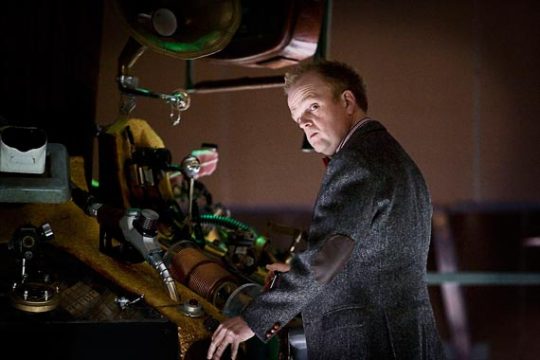
So stretcht out huge in length the Arch-fiend lay Chain'd on the burning Lake, nor ever thence Had ris'n or heav'd his head, but that the will And high permission of all-ruling Heaven Left him at large to his own dark designs, That with reiterated crimes he might Heap on himself damnation…
— Paradise Lost (1674), John Milton
It would be nothing compared to the madness of a Time Lord. When his mind went it would unleash a storm across the surface of his brain. The Dark Design, the Time Lords called it, and went out of their way to hide the sufferers in institutions. The Doctor had known many insane Time Lords in his time, but no mad ones. Pretenders rather than kings.
How will I feel, when I am lost in the Dark Design? What will I think? No. He didn’t want to think about this. These were cold futures.
— Falls the Shadow (1994), Daniel O’Mahony
OMEGA: You dare threaten to destroy me? You wish to fight the will of Omega? DOCTOR: Yes, if I must. OMEGA: Then you shall, but you will fight the dark side of my mind.
— The Three Doctors (1973)
MASTER: There is some evil in all of us, Doctor, even you. The Valeyard is an amalgamation of the darker sides of your nature, somewhere between your twelfth and final incarnation. And I may say, you do not improve with age.
— The Trial of a Time Lord (1986)
DOCTOR: Sorry, wasn't it obvious? The Dream Lord was me. Psychic pollen. It's a mind parasite. It feeds on everything dark in you, gives it a voice, turns it against you.
— Amy’s Choice (2010)
Time Lords felt time flow through them, but more than that, they helped to shape and refine time and space around them. […] Their victories in the Time Wars fought in the generations after Rassilon had helped to stabilise the cosmos, they had laid down the foundations of the modern, rationalistic universe. Would a mad Time Lord have the opposite effect? Would his insanity become contagious, affecting the past and the future like a virus?
— The Infinity Doctors (1998), Lance Parkin
He might be enduring some punishment. A life sentence. […] But, if anyone had passed judgment, it would have been him.
What had most probably happened was that he’d gone mad. Not merely insane. Mad. Tumbled down into mental spaces a human being couldn’t even imagine, turning corners only a Time Lord could turn. Goodness knew what he might have done. Leaving him alone in some quiet corner of the universe would have been the only safe thing to do.
‘Heaven left him at large to his own Dark Design,’ he whispered, ‘that with reiterated crimes he might heap on himself damnation.’
Absolutely nothing he did now would matter. It would take him a lot of years to die.
— SLEEPY (1996), Kate Orman
#doctor who#dark design#the valeyard#dream lord#amy's choice#kate orman#lance parkin#daniel o'mahony#the infinity doctors#trial of a time lord#time lords#archival
32 notes
·
View notes
Text
God The Parliament of Rats is reminding me how much I love Daniel O'Mahony, downright tragic that he never wrote a full-length novel for BBC Books. The Man in the Velvet Mask slaps and honestly has a fascinating arc for Dodo even though I know it is quite controversial. I even quite like Falls the Shadow. It's that precisely calibrated brand of weirdness that hits me just right.
3 notes
·
View notes
Text

[ID: a photo of the Faction Paradox series book, Newton's Sleep, by Daniel O'Mahony against a dark grey background. End ID]
Look what arrived today!
1 note
·
View note
Photo









PEJ72′s fan covers for Magic Bullet’s Kaldor City audio series
32 notes
·
View notes
Text
“Her oracle stays at the window, seething playfully below his hood. He has fiercely intelligent eyes, neither as sharp nor as bright as his scar. His mouth is a succulent white smile in a lightless face. His people have nothing but contempt for the rituals of the Great Houses. She’s little better than prey to him, a bloodless snack for his long teeth and hungry mind. He breathes, honeyed air purring out of the cavities of his body. [pause] Your first oracle? “My last.” You think? But his kind were vanishing from the world. “They were escaping the War. They could see it coming.” And what fresh monsters filled the gaps they left behind? Grandiose pocket-cults like House Paradox? The renegade tendency? The paranoid labyrinths of interventionism? Tainted bloodlines and tainted presidencies? And you? Don't you think the War might be a cure for these new madnesses?
- Newtons Sleep, Daniel O’Mahony

31 notes
·
View notes
Text
A Rag and a Bone
As some of you saw, I found one of my “lost” Doctor Who holy grails, Daniel O’Mahony’s A Rag and a Bone! I’d been hunting high and low for this piece of fiction because the idea of O’Mahony writing a Sabbath-centric story was too good. There was literally no information whatsoever online as to what the story was actually about, but I love O’Mahony’s writing and the idea of him tackling Sabbath seemed like a match made in hell.
Finally getting a hold of this story, I must say that calling it “a Sabbath story by Daniel O’Mahony” is incredibly disingenuous, and while I dissect this story and share it all with you, I have to be completely honest and say that I have never been more confused at such a short piece of fiction in my life. Delighted, mind, but very confused.
This story was published in 2003′s Myth Makers Essentials, the famous fanzine’s special 40th anniversary celebration. Myth Makers has been rather a white whale of mine, most long out of print issues holding onto other holy grails, most notably Parkin’s Saldaamir and The School of Doom.
This story is more than a Sabbath tale, being a celebration of Doctor Who’s history, the history of the humans who keep Doctor Who going, as well as a celebration of the 2003 BBC prose continuity that, for all intents and purposes, was the Doctor Who at the time alongside Big Finish’s 1999-2003 years.
It’s also written by one of the closest things Doctor Who has ever had to Clive Barker, meaning that it’s a very disturbing celebration.
O’Mahony introduces his story with a discussion of what he considers one of Doctor Who’s essential elements:
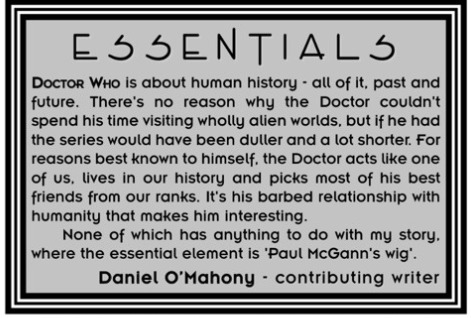
In O’Mahony’s view of the series, Doctor Who is about humanity. Human history, ingenuity, sacrifice. Without humanity, Doctor Who is nothing. It’s a much more grounded view on the series, and while I’m not sure I quite agree with it, it makes literally every Doctor Who story O’Mahony has written make a lot more sense.
I go into the story’s eccentricities and references (SO MANY REFERENCES GUYS, I’M SO HAPPY) under the cut. Reminder that a) O’Mahony, while a beautiful writer, is a very brutal one; his whole brand is painting objective horror and worldly ugliness in the richest, wine-like prose ever, and it’s definitely not for everyone, and b) this story, like Bidmead’s wonderful With All Awry, is far less literal than it is figurative. The continuity of the time is a factor in the story, but it’s rather useless to try and squeeze it in anywhere, that’s not it’s point.
A Rag and a Bone is an author’s thesis on the spirit of Doctor Who, as well as a simultaneous criticism and celebration of its state in 2003, all the while managing to use Sabbath in the manner he was intended, rarely seen outside of Lawrence Miles’ writing.
I’m not doing every passage of the thing, just the meatier ones. Enjoy and watch me stretch my English degree!
(Note, the story starts in first-person from Fitz’s POV, shifts to weird surreal mix of Fitz and O’Mahony himself, back to Fitz, and then ends with third person omniscient.)
The story opens up simply enough (which, given what appears to be going on, it’s really funny to say “simply”):
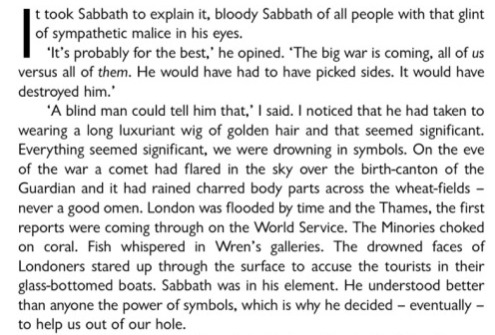
Already, this story seems to be following the beats of The Adventuress of Henrietta Street, the idea that in the universe without Time Lords, the universe is free game and humanity (led by Sabbath) needs to step up. But, it’s also a meta commentary. The passage is vague as to what’s really going on, but I think the war/looming disaster is something very specific, that I’ll touch on later.
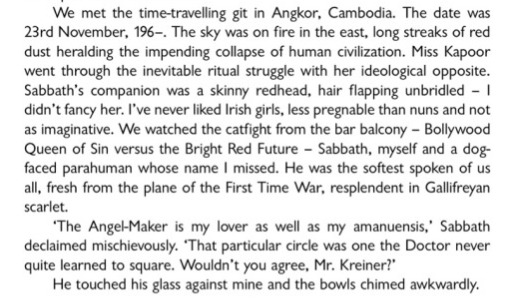
1) The date. Lmao. What could that possibly be a reference to?
2) Sabbath frequently had agents and allies throughout his novels, and one of these two, the Angel Maker, is actually from Lloyd Rose’s Camera Obscura. I don’t know if that gives an idea of the placement, or just further shows O’Mahony’s “I’m playing with current continuity” schtick.
3) “Miss Kapoor went through the inevitable ritual struggle with her ideological opposite [...] We watched the catfight from the bar balcony - Bollywood Queen of Sin versus the [Angel Maker]...” Perhaps a smirking jab at the rules or sterotypes of storytelling? Set certain characters against the idealogical opposites. Anji often went toe-to-toe with the ideologies and beliefs of people in her novels, far more than Fitz or the Doctor did, so I think that’s what this is a nod to, wrapped in the story’s theme of ritual and symbolism and framed as “the Doctor’s female companion must face Sabbath’s female companion in a duel!!!!!!!”
4) “... a dog-faced parahuman whose name I missed. He was the softest spoken of us all, fresh from the plane of the First Time War, resplendent in Gallifreyan scarlet.” This is Wardog (or a contemporary of Wardog), originally from Alan Moore’s DWM Black Sun Trilogy, portraying the First Time War. He had been recontexualized into Cold Fusion/The Infinity Doctors’ canon in Lance Parkin’s Executive Action, published in 2001′s Walking in Eternity, making him an (admittedly tangential) interesting cog in the EDA’s history and continuity.
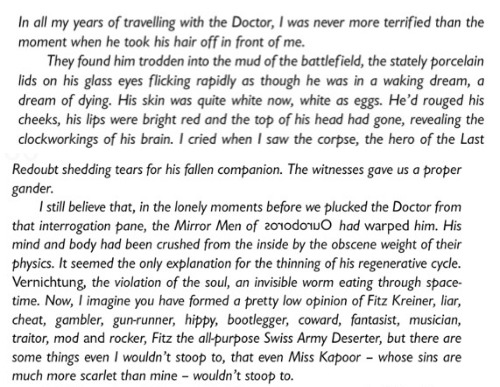
1) First time reading this passage, I couldn’t decide if this was purely Fitz or O’Mahony inserting himself into the narrative... and then I realized it’s both. There are two major critical takes on the companions, and this is the first: the role of the companions in the series is to give the audience someone to relate to and, in some cases, live vicariously through. Enjoying the adventure, experiencing the sights, etc. This section is both Fitz Kreiner and Daniel O’Mahony, trying to make sense of what’s going, while the story is already giving us the implications that, despite trying to create a narrative of the Doctor’s condition, he is actually not real.
2) Marvel at Fitz dragging himself in every possible way. Maybe a reference to how the novels (since the VNAs) really hadn’t had any qualms with pushing the flaws and imperfections of their characters? O’Mahony in particular is a writer who would go into great detail about how flawed people were.
3) “... Miss Kapoor - whose sins are much more scarlet than mine - wouldn’t stoop to.” I choose to believe this is a slight reference to how Anji was treating by some writers at the time. The EDA authors wither loved Anji, or hated and demonized her. I could be reaching with that one, but it doesn’t quite make much more sense otherwise. Maybe a reference to her earlier distrust and betrayals of the Doctor (such as in Mark Clapham’s Hope?)
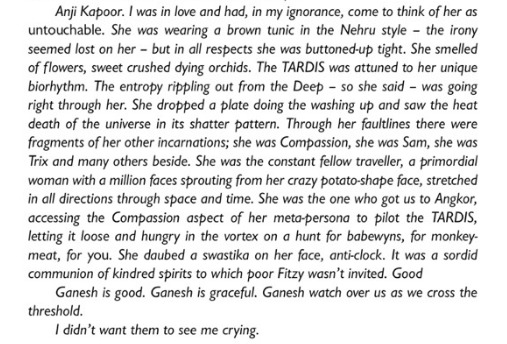
1) This is why I think O’Mahony was attacking the negative handlings of Anji, because the description of her character in the first few sentences is so... good. Beautiful, caring.
2) “The entropy rolling from the Deep...” I’m convinced that, in the end, the threat coming to destroy the universe, the stagnancy, the entropy, the “war,” is Doctor Who’s continued cancelation. Its the 40th anniversary, fourteen years since the show was cancelled, the series kept alive by a small and committed group of book readers and BF listeners (during BF’s early years). I’m adamant that the Wilderness Years produced some of the most creative and original Doctor Who ever, but it is very easy to see why people considered continuing the story a losing battle. More and more, the series slipped out of public consiousness and become more and more of an exclusive cult
3) The second critical take on companions in Doctor Who is a negative one (but one that needs to be said in some cases): in the end, they’re all interchangeable. None of their backstories or quirks matter in the end because they’re interchangeable stereotypes that need to stand their and ask the Doctor questions. What’s gorgeous about this sequence is how it tackles that idea in such a meta and independent way. Anji, realizing that she is, in fact, the latest face in a countless list, takes power from that. She reaches back to her predecessors and uses their abilities, their attributes, for her own agenda, all the while dressing as Anji Kapoor, praying to Ganesh as Anji Kapoor, being the unique and seperate entity that is Anji Kapoor.
4) “Babewyns.” The Ma’lakh grotesques, the villains of The Adventuress of Henrietta Street and one of the major elements in Faction Paradox.
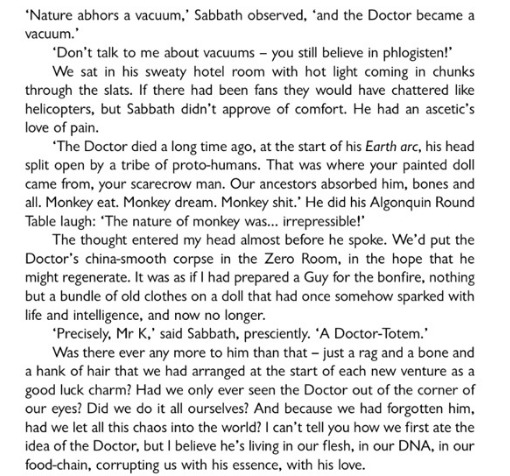


This section operates on two levels, both fictionally and metafictionally. The idea that the Doctor is now a vacuum and Sabbath must either fix or flat-out replace him is the central conflict of their relationship and adversity throughout their novels. There’s also a pun on the EDAs’ “Earth arc” which was the start of the status quo that brought in Sabbath. But, you’ll notice, the “Earth arc” here is not The Burning... it’s An Unearthly Child. Sabbath’s (very morbid) take of what happened to the Doctor isn’t the plot of the EDAs, it’s the beginnings of Doctor Who. The Doctor became part of human consciousness in 1963!
So why is the Doctor now a puppet? A doll, an inhuman echo? Because the show is cancelled, and despite the series living on through, there’s this overwhelming feeling that maybe, just maybe, the final end is fast approaching.
(Actually reading this theme in a story published two years before the show returned is rather nice, isn’t it?)
Sabbath’s take on this is, of course, negative and condescending, while Fitz focuses on the positivity of the Doctor. How he brings goodness and love into our lives, and that by “forgetting him,” (the show being cancelled) we’ve let horrible things into the world. That what Fitz is traveling with is the idea of the Doctor, the “totem” of what’s left, pushing through because Fitz/O’Mahony/the authors/the fans are still holding onto him.
This section also shows how Sabbath really, in the end, cannot replace the Doctor. His best appearances outside Adventuress (Parkin’s Trading Futures and Rose’s Camera Obscura) stressed his limitedness, his flaws, his (debatable) inability to rise to the occasion. He talks to Fitz about power vacuums and the state of the universe, and then Fitz immediately confronts him with his antiquated 19th century beliefs and ideals. Lawrence Miles always claimed Sabbath was never meant to actually replace the Doctor, but several authors, including Lance Parkin, have since expressed that this was not common knowledge and that many authors fully believed Miles was trying to push Sabbath on them as “the new Doctor.” That’s what I think this is a response to (and mind, O’Mahony and Miles were colleagues and friends).
Here we see, we don’t need or want Sabbath. We just want our Doctor back.
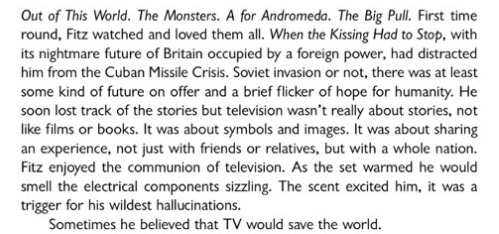
“Sometimes he believed that TV would save the world.” What a sad line, knowing the meaning of this story, huh?
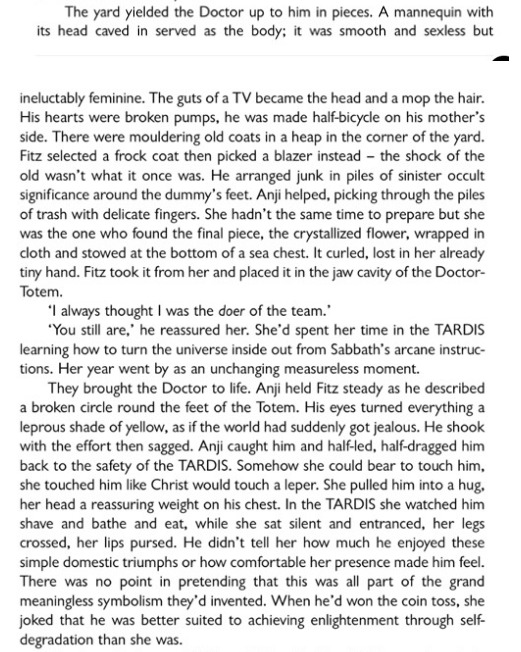
In the end of the story, Fitz and Anji rebuild their “Doctor-totem” from the junk of IM Foreman’s yard, literally using the ruins of the character’s humble 1963 beginnings to build the foundations. But remember, their Doctor is the Doctor of the novels. There’s more work to do to recreate their perception of him.
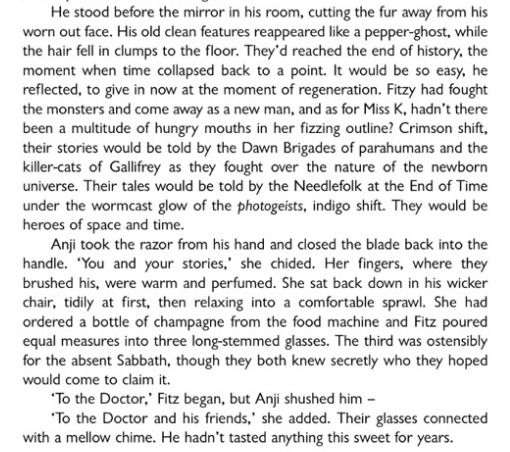
1) “Dawn Brigades of parahumans and the killer-cats of Gallifrey as they fought over the nature of the newborn universe.” Wardog’s Special Executive (representing the might and will of Rassilon) and the villains planned for the original story replaced by 1977′s The Invasion of Time (who I think here represent the Pythia), clashing during the universe’s minting (later known in Faction Paradox as the anchoring of the thread). This take on Gallifrey’s history (VNAs, EDAs, FP) is THE Gallifrey at the time of 2003.
2) “Their tales would be told by the Needlefolk at the End of Time...” The Needle, seen in The Infinity Doctors, Unnatural History, Father Time, Miranda, and alluded to or contextual related to in Hope and The Gallifrey Chronicles. An important aspect of the lore at the time!
3) This ending is so beautiful, if sad. Here is where Fitz and Anji fully represent the Doctor Who fans and creators at the time. Using their stories, their (new) adventures to further coax their Doctor back to life. He’s built from the junk and refuse of the dead Classic series, he’s lavished with the stories and lore of the Wilderness Years. He is part of humanity, he’s in us, as long as he as friends (the fans) trying to keep him alive.
#Doctor Who#Long post#Daniel O'Mahony#Eighth Doctor Adventures#Faction Paradox#Eighth Doctor#Fitz Kreiner#Anji Kapoor#Sabbath Dei#A Rag and a Bone#Myth Makers Essentials#The Adventuress of Henrietta Street#Lance Parkin#Lloyd Rose
55 notes
·
View notes
Photo







The Woman Who Killed the Doctor, by Daniel O’Mahony and Steve Andrew, published in Vworp Vworp # 3
(link to part 1)
61 notes
·
View notes